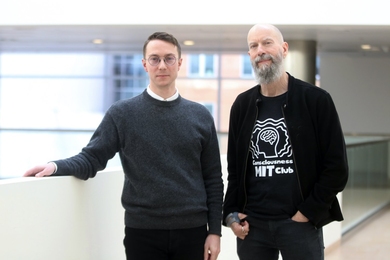In work that suggests a new treatment for adult-onset diabetes, a research team at the Broad Institute of MIT and Harvard has found a gene that revs up the energy-producing ability of muscle cells. Doing so could lessen the harmful effects of the disease.
The researchers studied mitochondria--tiny structures inside cells that take in oxygen and pump out energy. "We have identified three proteins that form a regulatory circuit in controlling the amount of mitochondria," said study leader Vamsi Mootha, a postdoctoral fellow at the Broad Institute. "In principle, a drug that acts on these proteins to boost the energy-producing machinery in muscle may ameliorate diabetes. This circuit represents an excellent drug target for the disease."
The study appears in the online edition of the Proceedings of the National Academy of Sciences during the week of April 20. It follows mounting evidence from several research groups, including work previously published by Mootha and colleagues at the Broad Institute, that the genes responsible for the primary function of mitochondria turn up less frequently in the muscles of diabetics and those at risk for diabetes.
This body of research has "important implications for dissecting regulatory networks in mammalian systems, for understanding mitochondrial biology and for treating type 2, or adult-onset, diabetes," Mootha said. Type 2 diabetes affects more than 110 million people worldwide and is a chief contributor to atherosclerotic vascular disease, blindness and kidney failure.
The primary metabolic process within mitochondria is called oxidative phosphorylation. The researchers predict that manipulating the genetic pathway for oxidative phosphorylation may provide a way to treat type 2 diabetes.
"Interestingly, this same cellular pathway can get turned on in response to exercise, which is one of the best ways to improve insulin resistance," Mootha said. Diabetics are strongly encouraged to exercise to lessen their reliance on medication.
Broad Institute researchers are also investigating whether mutations or variations in the genes encoding these proteins may predispose individuals to future development of type 2 diabetes.
The researchers used a combination of gene expression profiling and computational analysis. "Gene expression profiling allowed us to monitor the expression of more than 10,000 genes at once. We then applied new computational biology to make very specific predictions about what proteins regulate the formation of mitochondria," Mootha said.
"Our colleagues Christoph Handschin and Bruce Spiegelman of the Dana Farber Cancer Institute then provided convincing experimental validation of this proposed model. We'd like to apply such strategies to other biological processes and diseases with the goal of identifying additional disease genes and drug targets," Mootha said.
Mootha led a 15-member research team that included Broad Institute director and MIT Professor of Biology Eric Lander; Daniel Arlow, a sophomore in MIT's Department of Electrical Engineering and Computer Science; and additional collaborators at Dana Farber and X-Ceptor Therapeutics in San Diego.
The Howard Hughes Medical Institute and the National Institutes of Health supported this work.
The Broad Institute is a research collaboration of MIT, Harvard University and its affiliated hospitals, and the Whitehead Institute for Biomedical Research. Its mission is to propel genomic research by creating comprehensive tools for genomic medicine and making them available to scientists worldwide.
A version of this article appeared in MIT Tech Talk on May 5, 2004.






